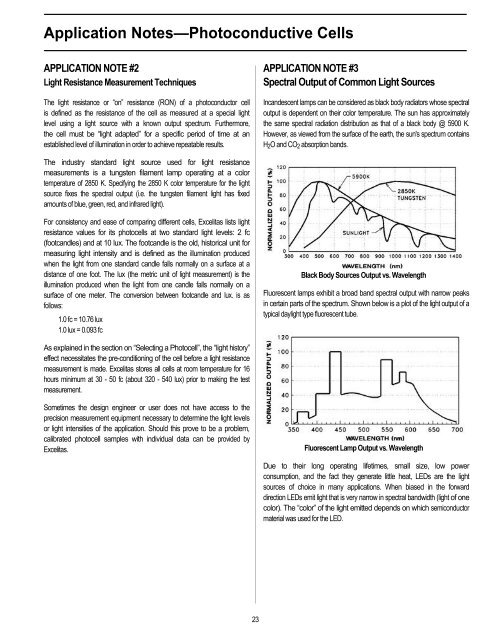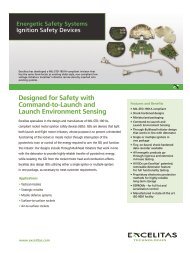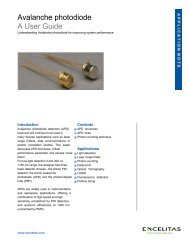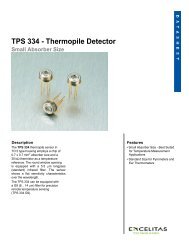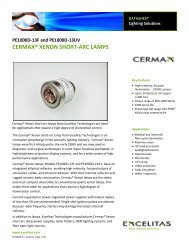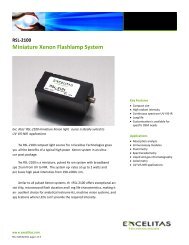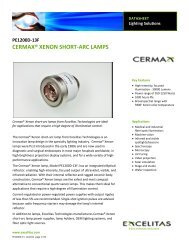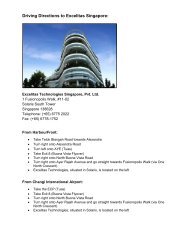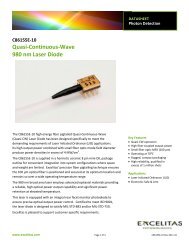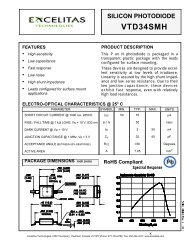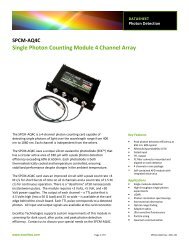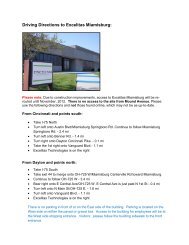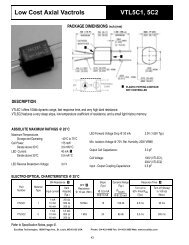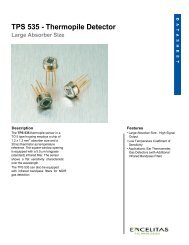Application Notes—Photoconductive Cells - Pacer
Application Notes—Photoconductive Cells - Pacer
Application Notes—Photoconductive Cells - Pacer
You also want an ePaper? Increase the reach of your titles
YUMPU automatically turns print PDFs into web optimized ePapers that Google loves.
<strong>Application</strong> <strong>Notes—Photoconductive</strong> <strong>Cells</strong><br />
APPLICATION NOTE #2<br />
Light Resistance Measurement Techniques<br />
The light resistance or “on” resistance (RON) of a photoconductor cell<br />
is defined as the resistance of the cell as measured at a special light<br />
level using a light source with a known output spectrum. Furthermore,<br />
the cell must be “light adapted” for a specific period of time at an<br />
established level of illumination in order to achieve repeatable results.<br />
The industry standard light source used for light resistance<br />
measurements is a tungsten filament lamp operating at a color<br />
temperature of 2850 K. Specifying the 2850 K color temperature for the light<br />
source fixes the spectral output (i.e. the tungsten filament light has fixed<br />
amounts of blue, green, red, and infrared light).<br />
For consistency and ease of comparing different cells, Excelitas lists light<br />
resistance values for its photocells at two standard light levels: 2 fc<br />
(footcandles) and at 10 lux. The footcandle is the old, historical unit for<br />
measuring light intensity and is defined as the illumination produced<br />
when the light from one standard candle falls normally on a surface at a<br />
distance of one foot. The lux (the metric unit of light measurement) is the<br />
illumination produced when the light from one candle falls normally on a<br />
surface of one meter. The conversion between footcandle and lux. is as<br />
follows:<br />
1.0 fc = 10.76 lux<br />
1.0 lux = 0.093 fc<br />
As explained in the section on “Selecting a Photocell”, the “light history”<br />
effect necessitates the pre-conditioning of the cell before a light resistance<br />
measurement is made. Excelitas stores all cells at room temperature for 16<br />
hours minimum at 30 - 50 fc (about 320 - 540 lux) prior to making the test<br />
measurement.<br />
Sometimes the design engineer or user does not have access to the<br />
precision measurement equipment necessary to determine the light levels<br />
or light intensities of the application. Should this prove to be a problem,<br />
calibrated photocell samples with individual data can be provided by<br />
Excelitas.<br />
23<br />
APPLICATION NOTE #3<br />
Spectral Output of Common Light Sources<br />
Incandescent lamps can be considered as black body radiators whose spectral<br />
output is dependent on their color temperature. The sun has approximately<br />
the same spectral radiation distribution as that of a black body @ 5900 K.<br />
However, as viewed from the surface of the earth, the sun's spectrum contains<br />
H2O and CO2 absorption bands.<br />
Black Body Sources Output vs. Wavelength<br />
Fluorescent lamps exhibit a broad band spectral output with narrow peaks<br />
in certain parts of the spectrum. Shown below is a plot of the light output of a<br />
typical daylight type fluorescent tube.<br />
Fluorescent Lamp Output vs. Wavelength<br />
Due to their long operating lifetimes, small size, low power<br />
consumption, and the fact they generate little heat, LEDs are the light<br />
sources of choice in many applications. When biased in the forward<br />
direction LEDs emit light that is very narrow in spectral bandwidth (light of one<br />
color). The “color” of the light emitted depends on which semiconductor<br />
material was used for the LED.


